Some English stress mistakes and solutions - A phonetic experimental research on Vietnamese students
The combination of phonological knowledge with rhythm and English stress rules is one of the solutions for English stress problems facing Vietnamese students. From the phonetic experiment, some types of stress mistakes made by Vietnamese students were discovered. The hypothesis is that the English Rhythmic patterns and English stress rules will help students to solve their stress problems. However, the English stress rules are so complicated. Therefore, based on the main rhythmic pattern, the key for stress rules has been raised to simplify the way to recognize stressed syllables. The final target is to help Vietnamese students identify English words through different ways of stress placement in order to increase their pronunciation ability as well as catching the main idea in the conversation to improve their communicative skill in English
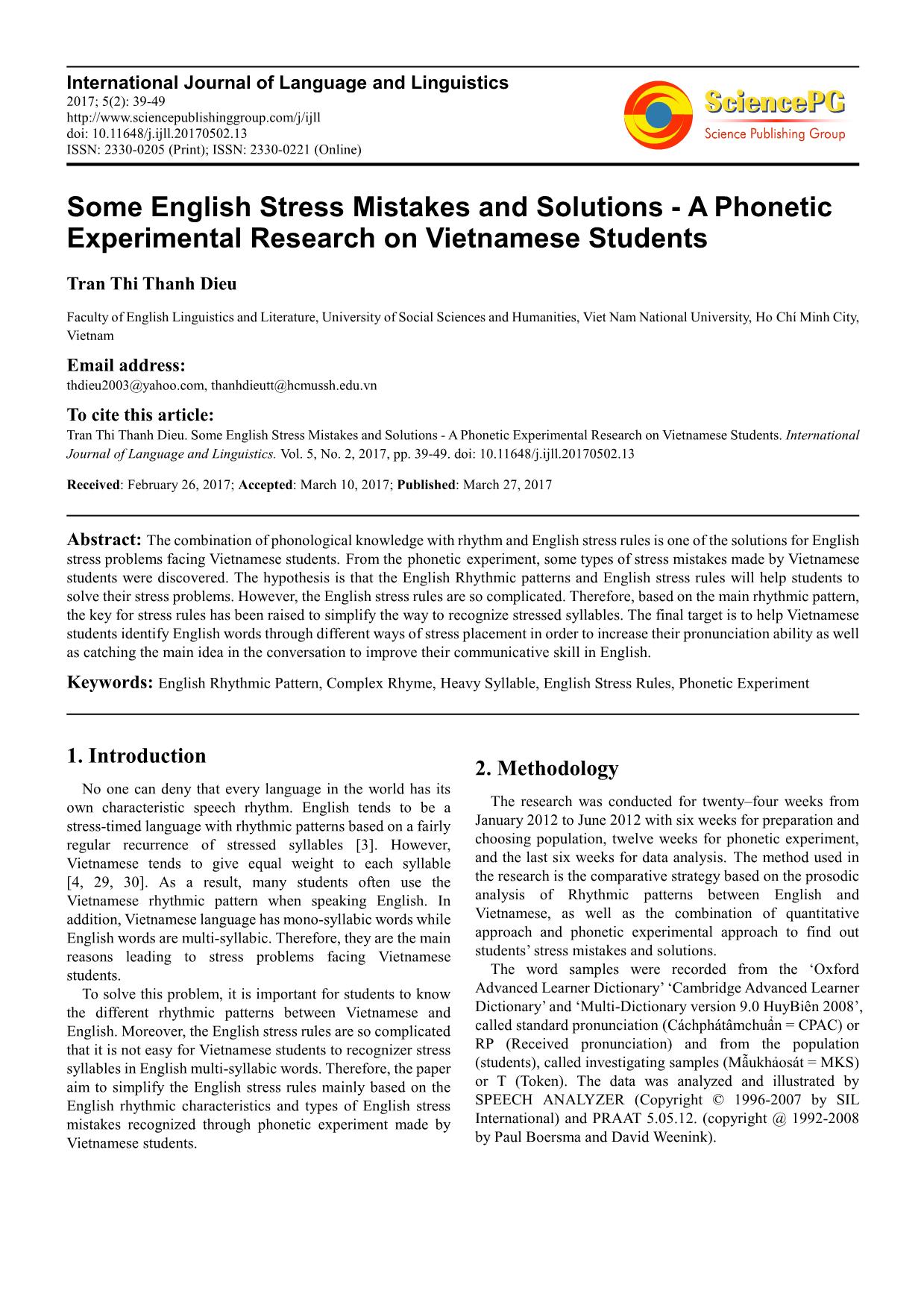
Trang 1
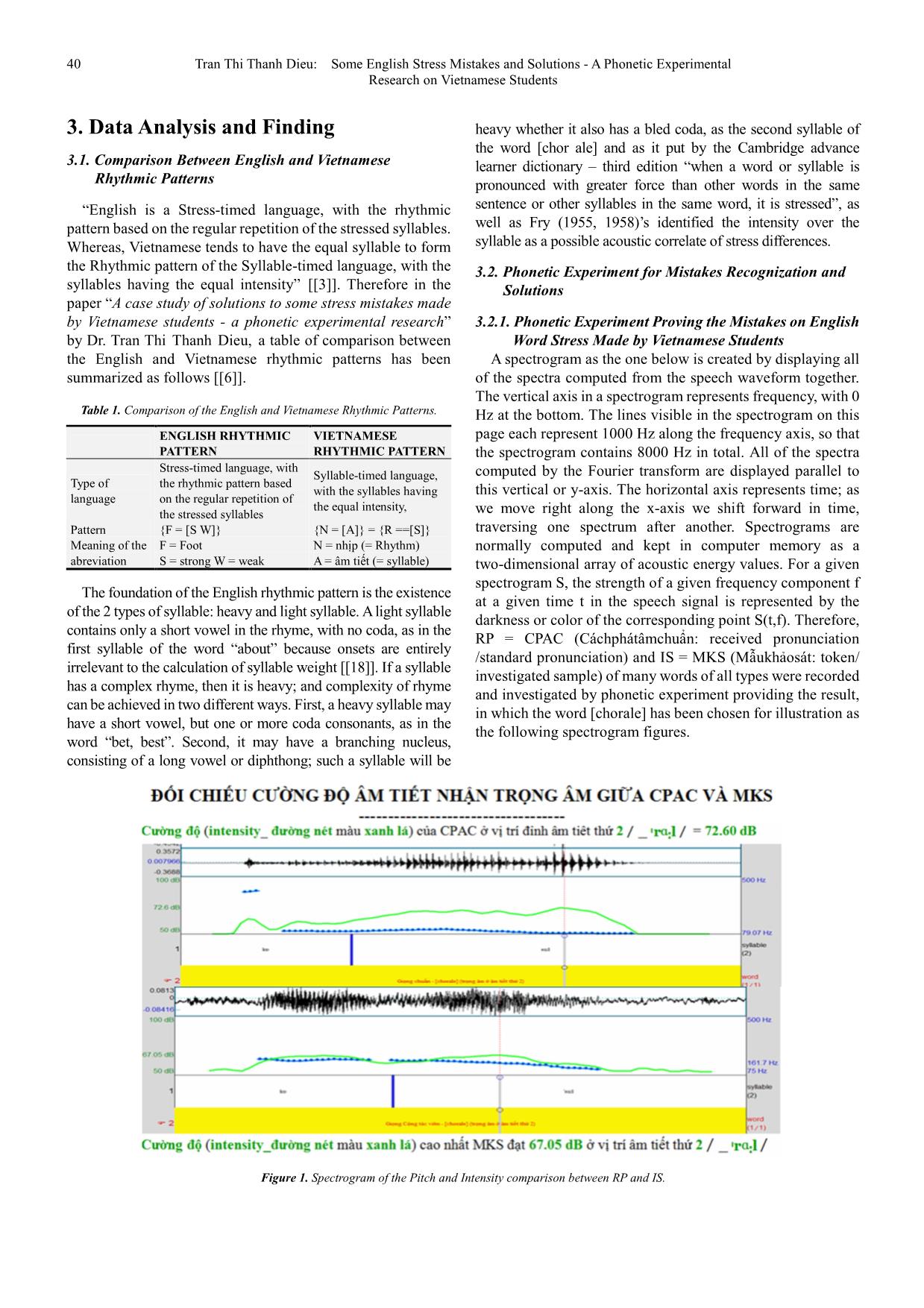
Trang 2
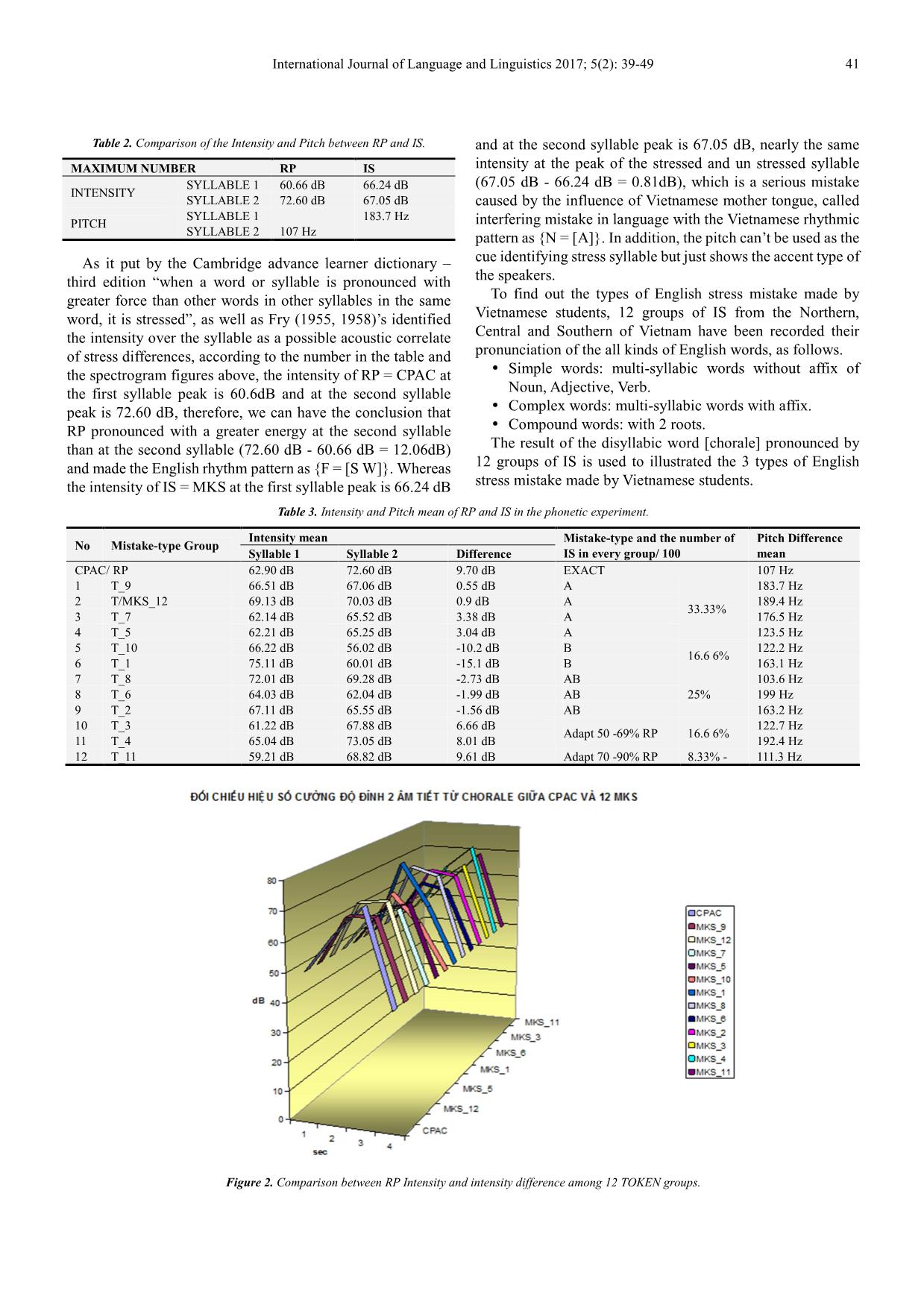
Trang 3
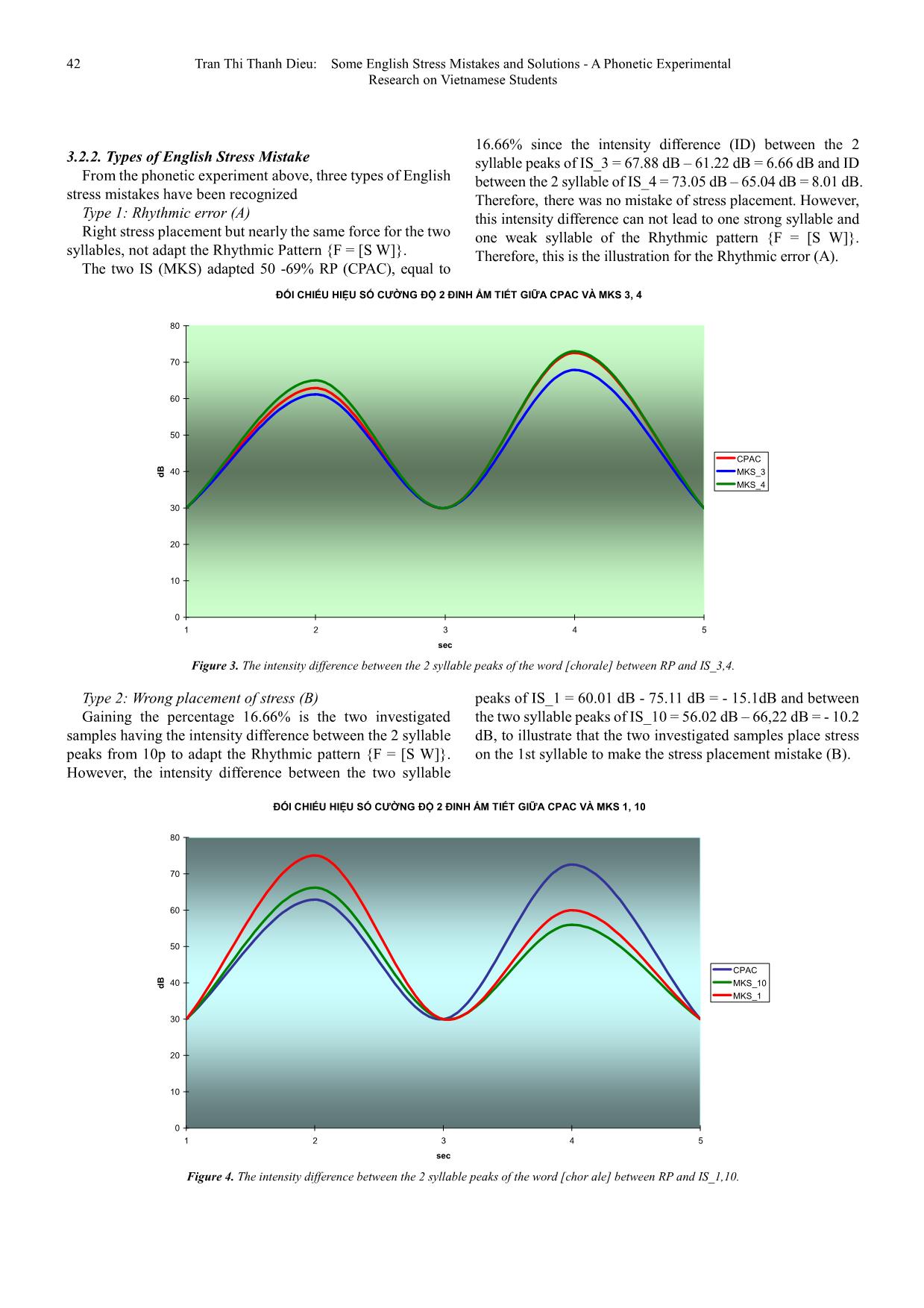
Trang 4
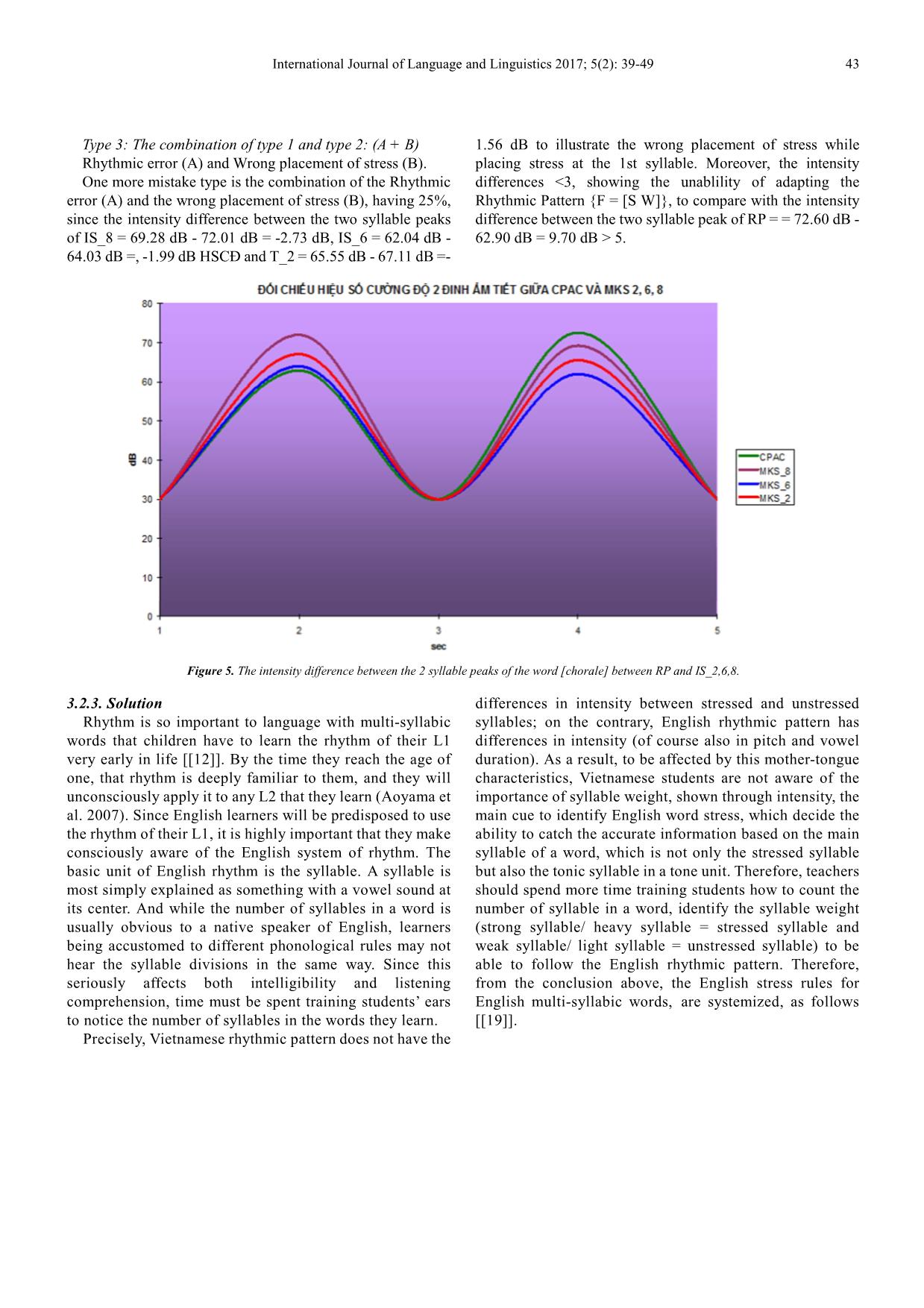
Trang 5
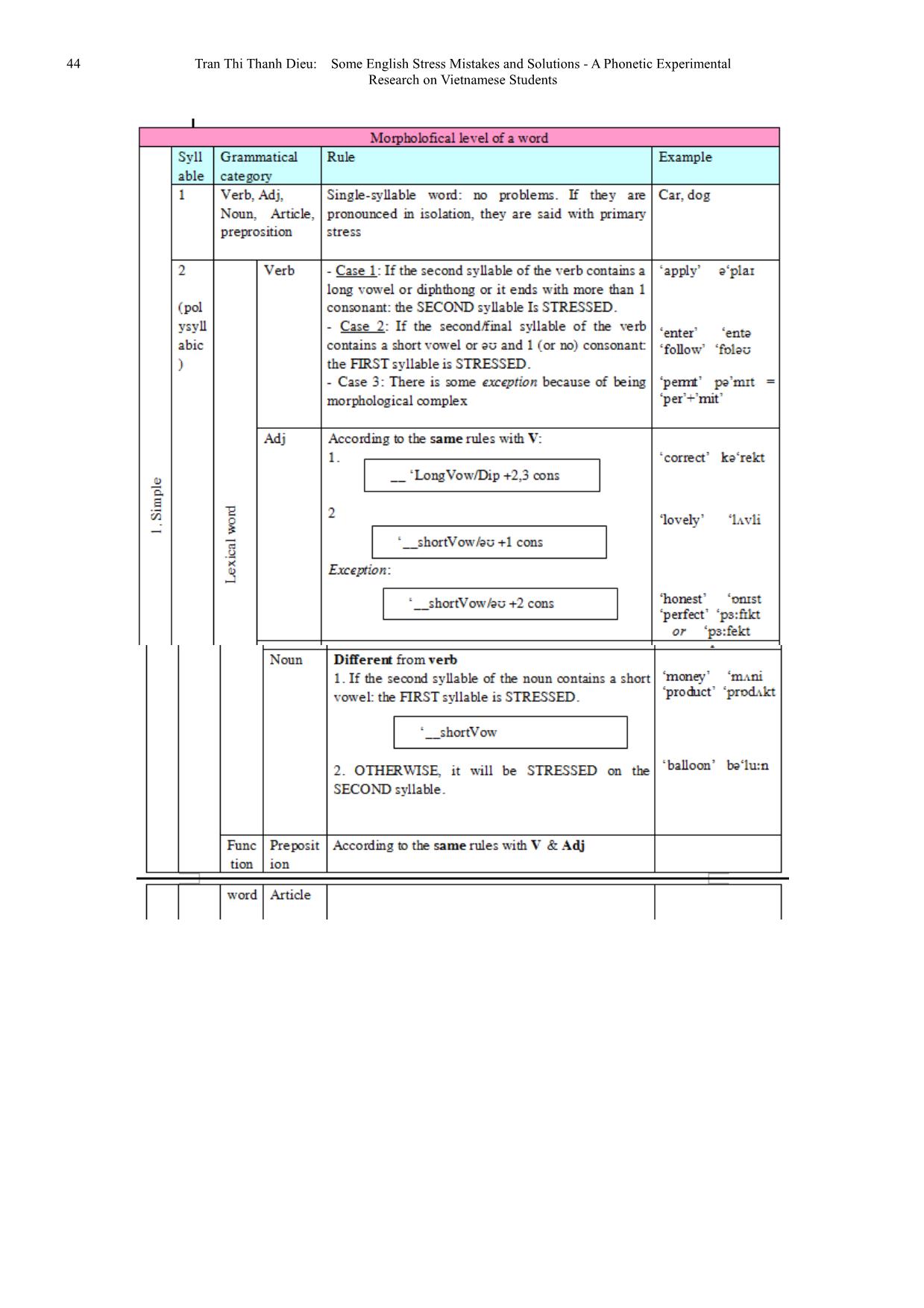
Trang 6
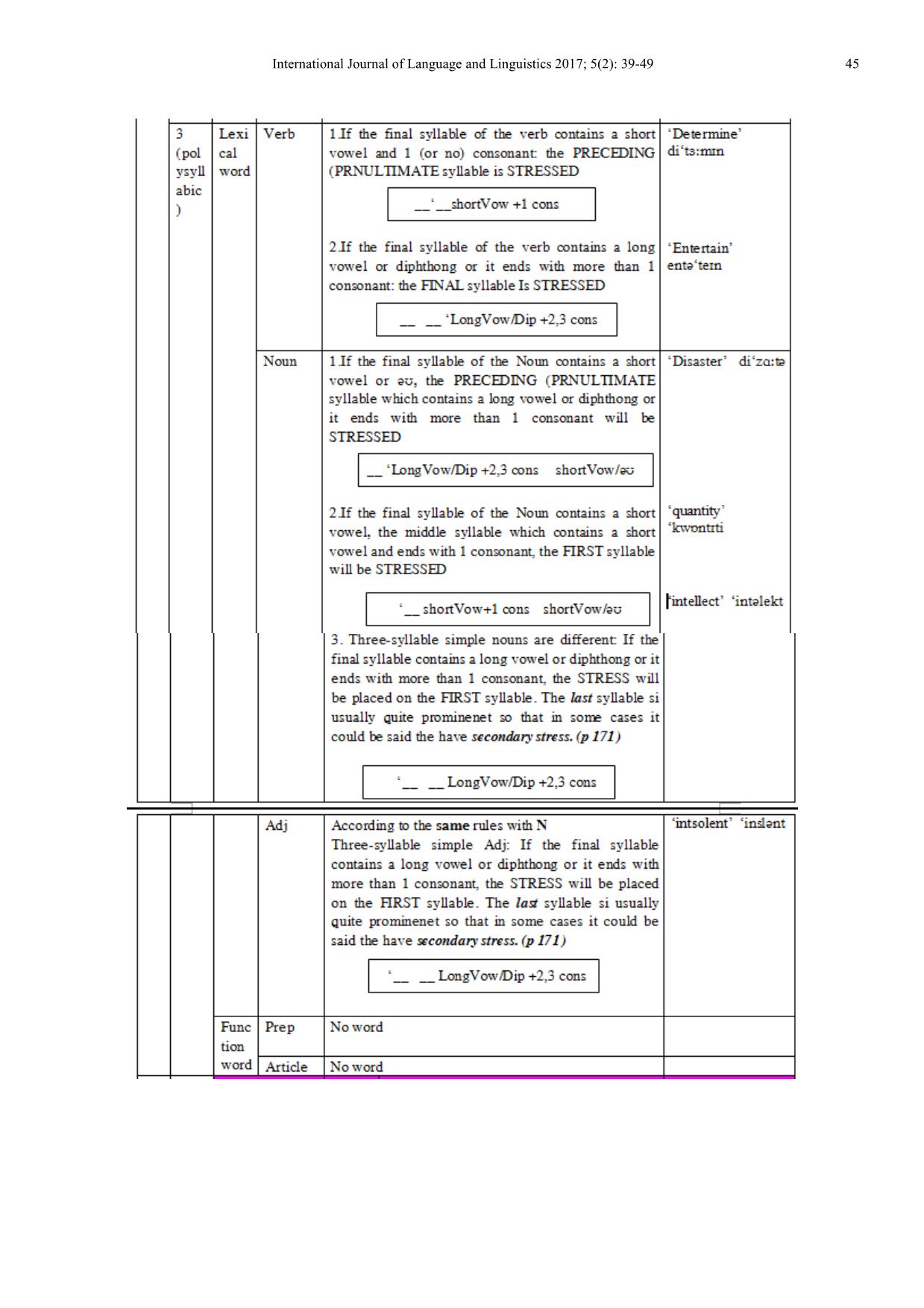
Trang 7
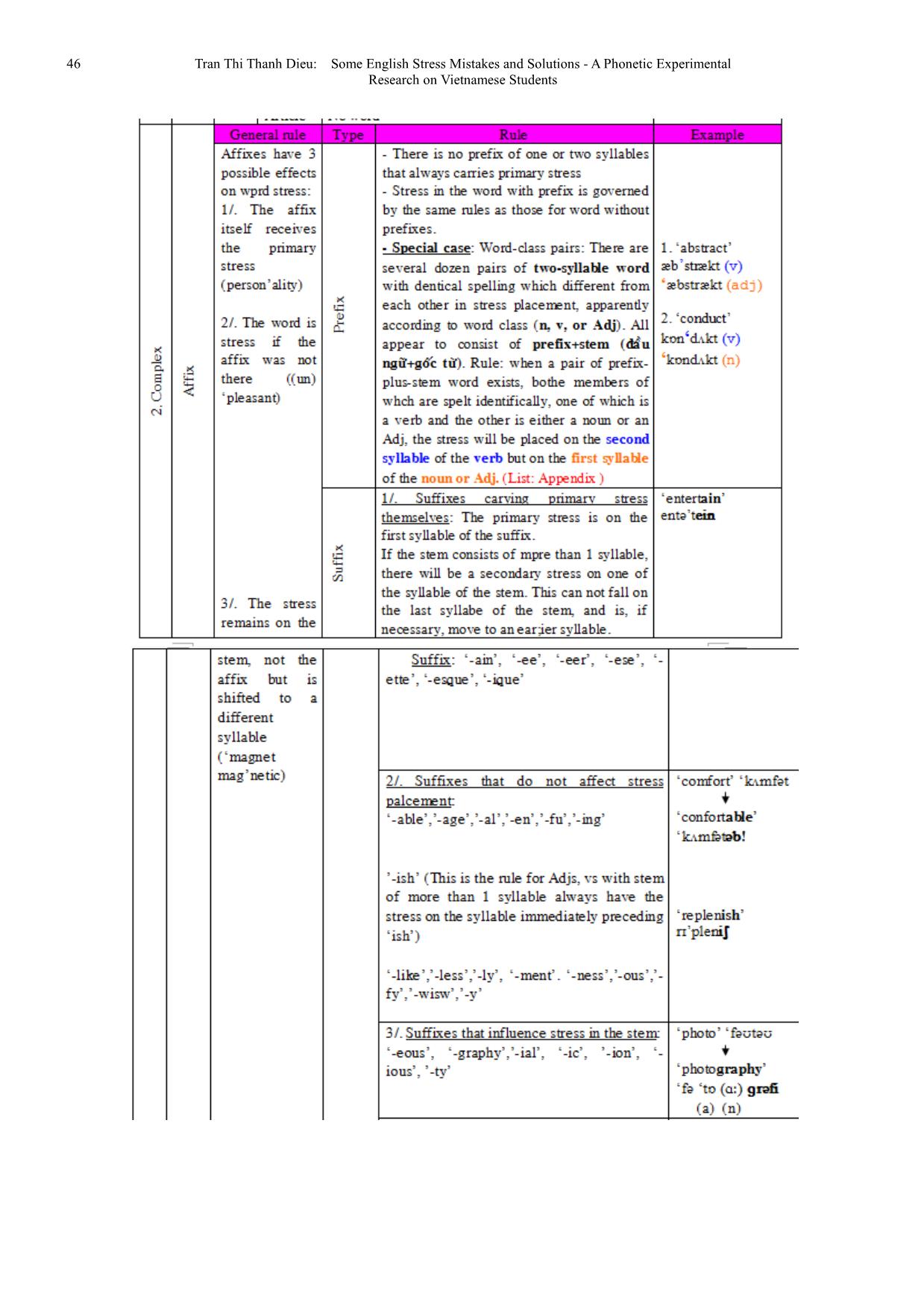
Trang 8
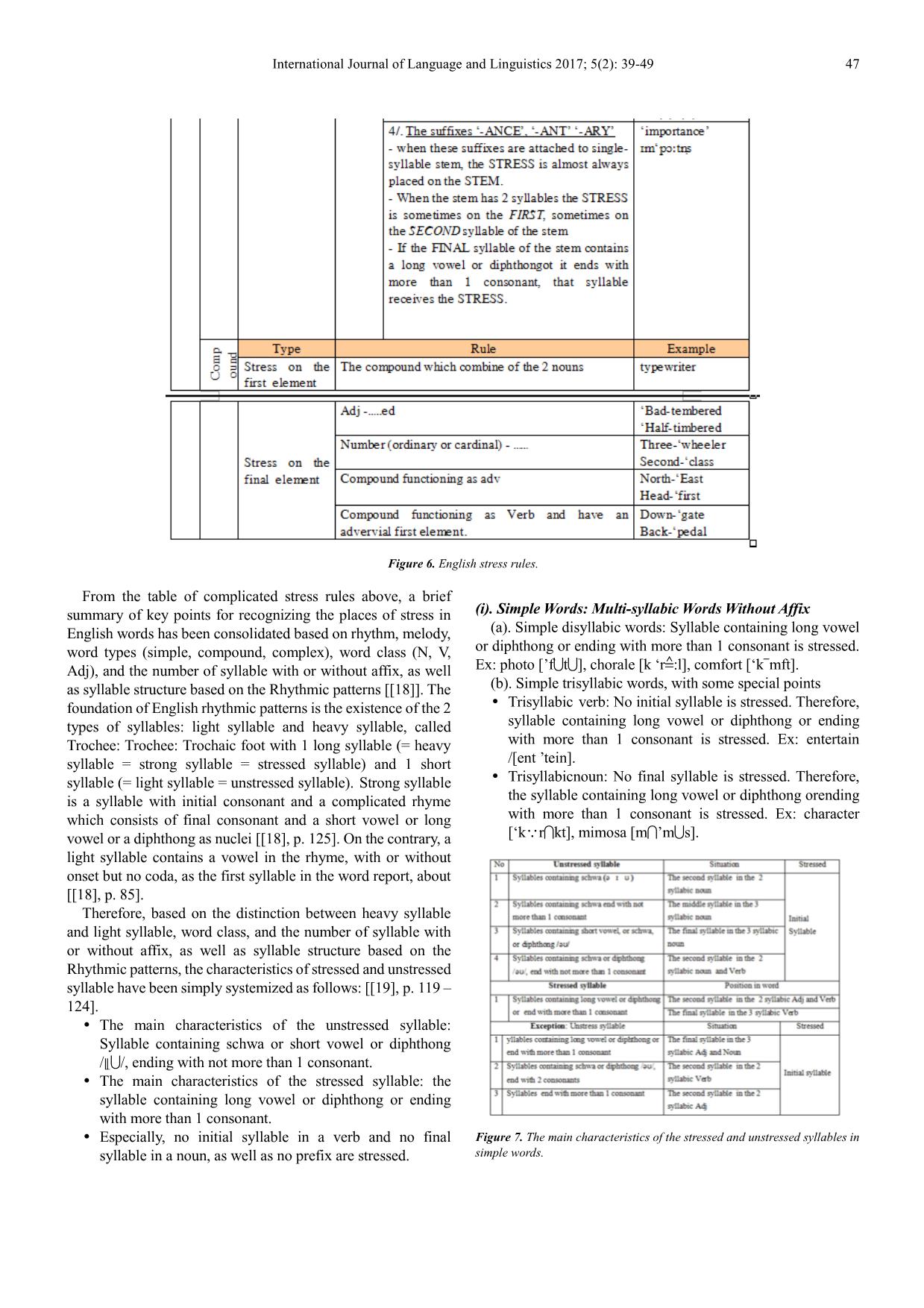
Trang 9
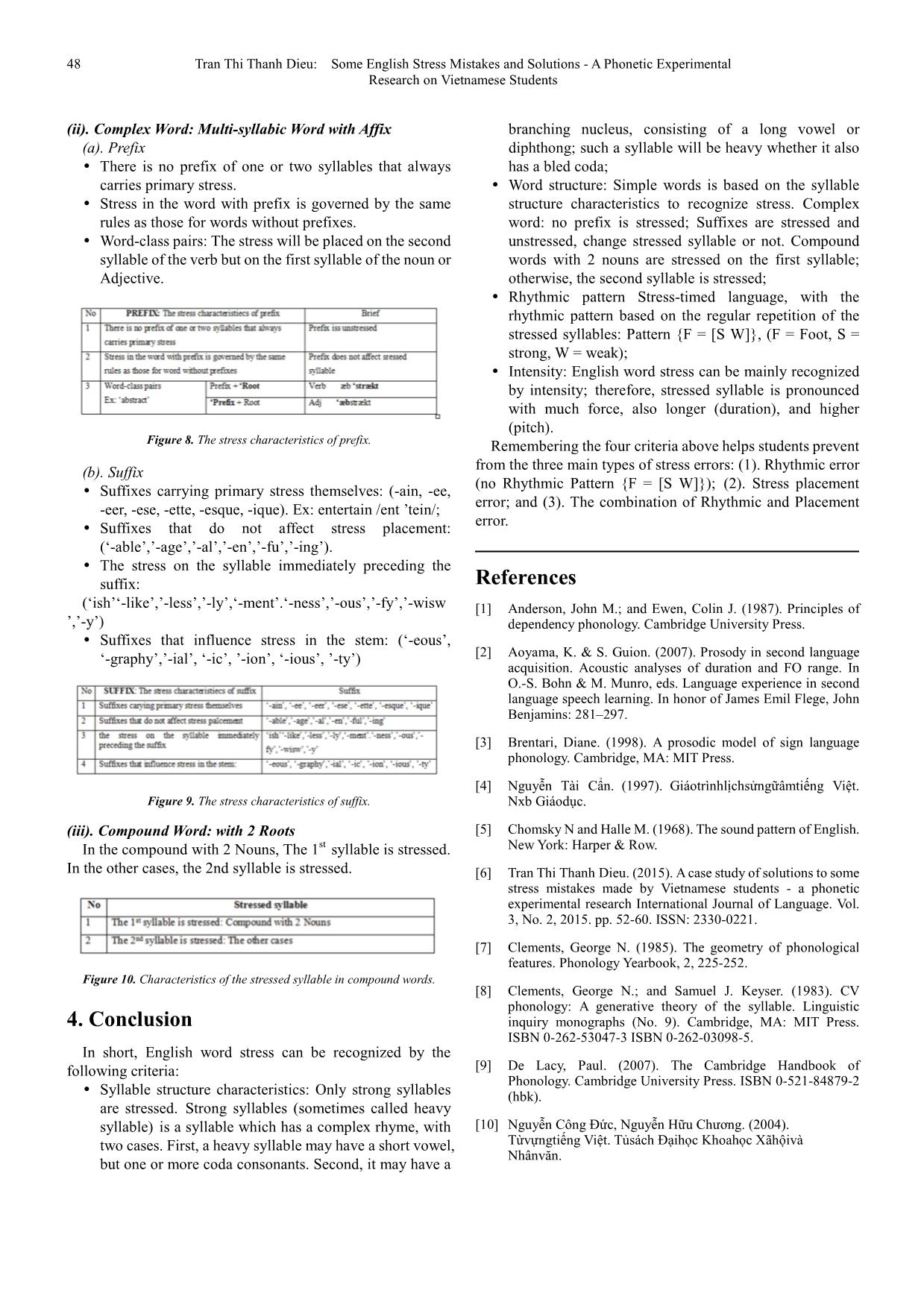
Trang 10
Tải về để xem bản đầy đủ
Tóm tắt nội dung tài liệu: Some English stress mistakes and solutions - A phonetic experimental research on Vietnamese students
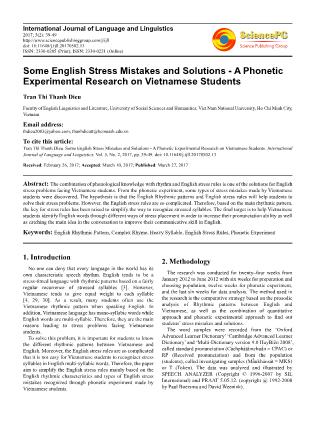
ference among 12 TOKEN groups.
42 Tran Thi Thanh Dieu: Some English Stress Mistakes and Solutions - A Phonetic Experimental
Research on Vietnamese Students
3.2.2. Types of English Stress Mistake
From the phonetic experiment above, three types of English
stress mistakes have been recognized
Type 1: Rhythmic error (A)
Right stress placement but nearly the same force for the two
syllables, not adapt the Rhythmic Pattern {F = [S W]}.
The two IS (MKS) adapted 50 -69% RP (CPAC), equal to
16.66% since the intensity difference (ID) between the 2
syllable peaks of IS_3 = 67.88 dB – 61.22 dB = 6.66 dB and ID
between the 2 syllable of IS_4 = 73.05 dB – 65.04 dB = 8.01 dB.
Therefore, there was no mistake of stress placement. However,
this intensity difference can not lead to one strong syllable and
one weak syllable of the Rhythmic pattern {F = [S W]}.
Therefore, this is the illustration for the Rhythmic error (A).
Figure 3. The intensity difference between the 2 syllable peaks of the word [chorale] between RP and IS_3,4.
Type 2: Wrong placement of stress (B)
Gaining the percentage 16.66% is the two investigated
samples having the intensity difference between the 2 syllable
peaks from 10p to adapt the Rhythmic pattern {F = [S W]}.
However, the intensity difference between the two syllable
peaks of IS_1 = 60.01 dB - 75.11 dB = - 15.1dB and between
the two syllable peaks of IS_10 = 56.02 dB – 66,22 dB = - 10.2
dB, to illustrate that the two investigated samples place stress
on the 1st syllable to make the stress placement mistake (B).
Figure 4. The intensity difference between the 2 syllable peaks of the word [chor ale] between RP and IS_1,10.
ĐỐI CHIẾU HIỆU SỐ CƯỜNG ĐỘ 2 ĐINH ẨM TIẾT GIỮA CPAC VÀ MKS 3, 4
0
10
20
30
40
50
60
70
80
1 2 3 4 5
sec
d
B
CPAC
MKS_3
MKS_4
ĐỐI CHIẾU HIỆU SỐ CƯỜNG ĐỘ 2 ĐINH ẨM TIẾT GIỮA CPAC VÀ MKS 1, 10
0
10
20
30
40
50
60
70
80
1 2 3 4 5
sec
d
B
CPAC
MKS_10
MKS_1
International Journal of Language and Linguistics 2017; 5(2): 39-49 43
Type 3: The combination of type 1 and type 2: (A + B)
Rhythmic error (A) and Wrong placement of stress (B).
One more mistake type is the combination of the Rhythmic
error (A) and the wrong placement of stress (B), having 25%,
since the intensity difference between the two syllable peaks
of IS_8 = 69.28 dB - 72.01 dB = -2.73 dB, IS_6 = 62.04 dB -
64.03 dB =, -1.99 dB HSCĐ and T_2 = 65.55 dB - 67.11 dB =-
1.56 dB to illustrate the wrong placement of stress while
placing stress at the 1st syllable. Moreover, the intensity
differences <3, showing the unablility of adapting the
Rhythmic Pattern {F = [S W]}, to compare with the intensity
difference between the two syllable peak of RP = = 72.60 dB -
62.90 dB = 9.70 dB > 5.
Figure 5. The intensity difference between the 2 syllable peaks of the word [chorale] between RP and IS_2,6,8.
3.2.3. Solution
Rhythm is so important to language with multi-syllabic
words that children have to learn the rhythm of their L1
very early in life [[12]]. By the time they reach the age of
one, that rhythm is deeply familiar to them, and they will
unconsciously apply it to any L2 that they learn (Aoyama et
al. 2007). Since English learners will be predisposed to use
the rhythm of their L1, it is highly important that they make
consciously aware of the English system of rhythm. The
basic unit of English rhythm is the syllable. A syllable is
most simply explained as something with a vowel sound at
its center. And while the number of syllables in a word is
usually obvious to a native speaker of English, learners
being accustomed to different phonological rules may not
hear the syllable divisions in the same way. Since this
seriously affects both intelligibility and listening
comprehension, time must be spent training students’ ears
to notice the number of syllables in the words they learn.
Precisely, Vietnamese rhythmic pattern does not have the
differences in intensity between stressed and unstressed
syllables; on the contrary, English rhythmic pattern has
differences in intensity (of course also in pitch and vowel
duration). As a result, to be affected by this mother-tongue
characteristics, Vietnamese students are not aware of the
importance of syllable weight, shown through intensity, the
main cue to identify English word stress, which decide the
ability to catch the accurate information based on the main
syllable of a word, which is not only the stressed syllable
but also the tonic syllable in a tone unit. Therefore, teachers
should spend more time training students how to count the
number of syllable in a word, identify the syllable weight
(strong syllable/ heavy syllable = stressed syllable and
weak syllable/ light syllable = unstressed syllable) to be
able to follow the English rhythmic pattern. Therefore,
from the conclusion above, the English stress rules for
English multi-syllabic words, are systemized, as follows
[[19]].
44 Tran Thi Thanh Dieu: Some English Stress Mistakes and Solutions - A Phonetic Experimental
Research on Vietnamese Students
International Journal of Language and Linguistics 2017; 5(2): 39-49 45
46 Tran Thi Thanh Dieu: Some English Stress Mistakes and Solutions - A Phonetic Experimental
Research on Vietnamese Students
International Journal of Language and Linguistics 2017; 5(2): 39-49 47
Figure 6. English stress rules.
From the table of complicated stress rules above, a brief
summary of key points for recognizing the places of stress in
English words has been consolidated based on rhythm, melody,
word types (simple, compound, complex), word class (N, V,
Adj), and the number of syllable with or without affix, as well
as syllable structure based on the Rhythmic patterns [[18]]. The
foundation of English rhythmic patterns is the existence of the 2
types of syllables: light syllable and heavy syllable, called
Trochee: Trochee: Trochaic foot with 1 long syllable (= heavy
syllable = strong syllable = stressed syllable) and 1 short
syllable (= light syllable = unstressed syllable). Strong syllable
is a syllable with initial consonant and a complicated rhyme
which consists of final consonant and a short vowel or long
vowel or a diphthong as nuclei [[18], p. 125]. On the contrary, a
light syllable contains a vowel in the rhyme, with or without
onset but no coda, as the first syllable in the word report, about
[[18], p. 85].
Therefore, based on the distinction between heavy syllable
and light syllable, word class, and the number of syllable with
or without affix, as well as syllable structure based on the
Rhythmic patterns, the characteristics of stressed and unstressed
syllable have been simply systemized as follows: [[19], p. 119 –
124].
The main characteristics of the unstressed syllable:
Syllable containing schwa or short vowel or diphthong
/∪/, ending with not more than 1 consonant.
The main characteristics of the stressed syllable: the
syllable containing long vowel or diphthong or ending
with more than 1 consonant.
Especially, no initial syllable in a verb and no final
syllable in a noun, as well as no prefix are stressed.
(i). Simple Words: Multi-syllabic Words Without Affix
(a). Simple disyllabic words: Syllable containing long vowel
or diphthong or ending with more than 1 consonant is stressed.
Ex: photo [’f∪t∪], chorale [k ‘r≙:l], comfort [‘kmft].
(b). Simple trisyllabic words, with some special points
Trisyllabic verb: No initial syllable is stressed. Therefore,
syllable containing long vowel or diphthong or ending
with more than 1 consonant is stressed. Ex: entertain
/[ent ’tein].
Trisyllabicnoun: No final syllable is stressed. Therefore,
the syllable containing long vowel or diphthong orending
with more than 1 consonant is stressed. Ex: character
[‘k∵r∩kt], mimosa [m∩’m∪s].
Figure 7. The main characteristics of the stressed and unstressed syllables in
simple words.
48 Tran Thi Thanh Dieu: Some English Stress Mistakes and Solutions - A Phonetic Experimental
Research on Vietnamese Students
(ii). Complex Word: Multi-syllabic Word with Affix
(a). Prefix
There is no prefix of one or two syllables that always
carries primary stress.
Stress in the word with prefix is governed by the same
rules as those for words without prefixes.
Word-class pairs: The stress will be placed on the second
syllable of the verb but on the first syllable of the noun or
Adjective.
Figure 8. The stress characteristics of prefix.
(b). Suffix
Suffixes carrying primary stress themselves: (-ain, -ee,
-eer, -ese, -ette, -esque, -ique). Ex: entertain /ent ’tein/;
Suffixes that do not affect stress placement:
(‘-able’,’-age’,’-al’,’-en’,’-fu’,’-ing’).
The stress on the syllable immediately preceding the
suffix:
(‘ish’‘-like’,’-less’,’-ly’,‘-ment’.‘-ness’,’-ous’,’-fy’,’-wisw
’,’-y’)
Suffixes that influence stress in the stem: (‘-eous’,
‘-graphy’,’-ial’, ‘-ic’, ’-ion’, ‘-ious’, ’-ty’)
Figure 9. The stress characteristics of suffix.
(iii). Compound Word: with 2 Roots
In the compound with 2 Nouns, The 1st syllable is stressed.
In the other cases, the 2nd syllable is stressed.
Figure 10. Characteristics of the stressed syllable in compound words.
4. Conclusion
In short, English word stress can be recognized by the
following criteria:
Syllable structure characteristics: Only strong syllables
are stressed. Strong syllables (sometimes called heavy
syllable) is a syllable which has a complex rhyme, with
two cases. First, a heavy syllable may have a short vowel,
but one or more coda consonants. Second, it may have a
branching nucleus, consisting of a long vowel or
diphthong; such a syllable will be heavy whether it also
has a bled coda;
Word structure: Simple words is based on the syllable
structure characteristics to recognize stress. Complex
word: no prefix is stressed; Suffixes are stressed and
unstressed, change stressed syllable or not. Compound
words with 2 nouns are stressed on the first syllable;
otherwise, the second syllable is stressed;
Rhythmic pattern Stress-timed language, with the
rhythmic pattern based on the regular repetition of the
stressed syllables: Pattern {F = [S W]}, (F = Foot, S =
strong, W = weak);
Intensity: English word stress can be mainly recognized
by intensity; therefore, stressed syllable is pronounced
with much force, also longer (duration), and higher
(pitch).
Remembering the four criteria above helps students prevent
from the three main types of stress errors: (1). Rhythmic error
(no Rhythmic Pattern {F = [S W]}); (2). Stress placement
error; and (3). The combination of Rhythmic and Placement
error.
References
[1] Anderson, John M.; and Ewen, Colin J. (1987). Principles of
dependency phonology. Cambridge University Press.
[2] Aoyama, K. & S. Guion. (2007). Prosody in second language
acquisition. Acoustic analyses of duration and FO range. In
O.-S. Bohn & M. Munro, eds. Language experience in second
language speech learning. In honor of James Emil Flege, John
Benjamins: 281–297.
[3] Brentari, Diane. (1998). A prosodic model of sign language
phonology. Cambridge, MA: MIT Press.
[4] Nguyễn Tài Cẩn. (1997). Giáotrìnhlịchsửngữâmtiếng Việt.
Nxb Giáodục.
[5] Chomsky N and Halle M. (1968). The sound pattern of English.
New York: Harper & Row.
[6] Tran Thi Thanh Dieu. (2015). A case study of solutions to some
stress mistakes made by Vietnamese students - a phonetic
experimental research International Journal of Language. Vol.
3, No. 2, 2015. pp. 52-60. ISSN: 2330-0221.
[7] Clements, George N. (1985). The geometry of phonological
features. Phonology Yearbook, 2, 225-252.
[8] Clements, George N.; and Samuel J. Keyser. (1983). CV
phonology: A generative theory of the syllable. Linguistic
inquiry monographs (No. 9). Cambridge, MA: MIT Press.
ISBN 0-262-53047-3 ISBN 0-262-03098-5.
[9] De Lacy, Paul. (2007). The Cambridge Handbook of
Phonology. Cambridge University Press. ISBN 0-521-84879-2
(hbk).
[10] Nguyễn Công Đức, Nguyễn Hữu Chương. (2004).
Từvựngtiếng Việt. Tủsách Đạihọc Khoahọc Xãhộivà
Nhânvăn.
International Journal of Language and Linguistics 2017; 5(2): 39-49 49
[11] Nguyễn Thiện Giáp. (2009).
Cácphươngphápnghiêncứungônngữ. Nxb Giáodục.
[12] Goldsmith, John A. (1995). "Phonological Theory". in John A.
Goldsmith. The Handbook of Phonological Theory. Blackwell
Handbooks in Linguistics. Blackwell Publishers.
[13] Goldsmith, John A. (1979). The aims of autosegmental
phonology. In D. A. Dinnsen (Ed.), Current approaches to
phonological theory. Bloomington: Indiana University Press.
[14] Cao XuânHạo. (2006). TiếngViệt, mấyvấnđềNgữâm, Ngữpháp,
Ngữnghĩa. NxbKhoahọcXãhội.
[15] NguyễnQuangHồng. (2002). Âmtiếtvàloạihìnhngônngữ. Nxb
Đạihọc Quốcgia HàNội.
[16] Jones D. 1909/ (2002). The pronunciation of English.
Cambridge University Press.
[17] Ladefoged, Peter. (2001). A course in phonetics (4th ed.).
Boston: Heinle & Heinle, Thomson Learning.
[18] McMahon A. (1988). An introduction to English phonology.
Edinburgh University Press.
[19] Roach, P. (1998). English Phonetics and Phonology. The Youth
Press, Vietnam.
[20] Spencer, A. (1991). Morphological Theory. Cambridge
University Press.
[21] Stump, G, T. (2001). Inflectional Morphology – A theory of
Paradigm Structure. Cambridge University Press.
[22] SEAMEO Regional Language Center. (2003). Research
Methodology. Singapore: SEAMEO Regional Language
Center.
[23] Griffee D. T. &Nunan D. (1997). Classroom Teachers and
Classroom research. Tokyo, Japan: The Japan Association for
Language Teaching.
[24] Hadley G. (2003). Action Research in Action. Singapore:
SEAMEO Regional Language Center.
[25] Hatch E and Lazaraton A, University of California. (1991). The
Research Manual Design and Statistics for Applied Linguistics.
Boston: Heinle & Heinle Publishers A Division of Wadsworth,
Inc Boston, Massachusetts 02116.
[26] Fry D. B. (1955). Duration and intensity as physical correlates
of linguistic stress. J. Acoust. Soc. Am. 27, 765–768. doi:
10.1121/1.1908022.
[27] Fry D. B. (1958). Experiments in the perception of stress. Lang
Speech 1, 126–152.
[28] Fry D. B. (1965). The dependence of stress judgments on vowel
formant structure. in Proceedings of the 5th International
Congress of Phonetics Sciences, eds. Zwerner X., and Bethge
W., Karger: Basel, pp. 306–311.
[29] Đinh Lê Thư, Nguyễn Văn Huệ. (1998). Cơcấungữâmtiếng
Việt. Nxb Giáodục.
[30] Đòan Thiện Thuật. (1980). Ngữâmtiếng Việt. Nxb Đạihọcvà
Trunghọcchuyênnghiệp.
[31] Lê Quang Thiêm. (2004). Nghiêncứuđốichiếucácngônngữ.
Nxb Đạihọc Quốcgia HàNội.
File đính kèm:
 some_english_stress_mistakes_and_solutions_a_phonetic_experi.pdf
some_english_stress_mistakes_and_solutions_a_phonetic_experi.pdf

